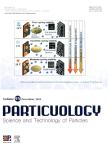CFD-DEM simulation of turbulence modulation in horizontal pneumatic conveying
CFD-DEM simulation of turbulence modulation in horizontal pneumatic conveying作者机构:Institute for Infrastructure and Environment School of Engineering The University of Edinburgh The King's Buildings Edinburgh EH9 3JL UK Department of Mechanical and Construction Engineering Northumbria University Ellison Place Newcastle-upon-Tyne NE1 8ST UK
出 版 物:《Particuology》 (颗粒学报(英文版))
年 卷 期:2017年第15卷第2期
页 面:15-24页
核心收录:
学科分类:07[理学]
基 金:Framework 7 Marie Curie European Commission, EC
主 题:Turbulence modulation Pneumatic conveying Eulerian Lagrangian approach Laser Doppler anemometry
摘 要:A study is presented to evaluate the capabilities of the standard k–ε turbulence model and the k–ε turbulence model with added source terms in predicting the experimentally measured turbulence modulation due to the presence of particles in horizontal pneumatic conveying, in the context of a CFD–DEM Eulerian–Lagrangian simulation. Experiments were performed using a 6.5-m long, 0.075-m diameter horizontal pipe in conjunction with a laser Doppler anemometry (LDA) system. Spherical glass beads with two sizes, 1.5 and 2 mm, were used. Simulations were performed using the commercial discrete element method software EDEM, coupled with the computational fluid dynamics package FLUENT. Hybrid source terms were added to the conventional k–ε turbulence model to take into account the influence of the dispersed phase on the carrier phase turbulence intensity. The simulation results showed that the turbulence modulation depends strongly on the model parameter Cε3. Both the standard k–ε turbulence model and the k–ε turbulence model with the hybrid source terms could predict the gas phase turbulence intensity trend only generally. A noticeable discrepancy in all cases between simulation and experimental results was observed, particularly for the regions close to the pipe wall. It was also observed that in some cases the addition of the source terms to the k–ε turbulence model did not improve the simulation results when compared with those of the standard k–ε turbulence model. Nonetheless, in the lower part of the pipe where particle loading was greater due to gravitational effects, the model with added source terms performed somewhat better.



